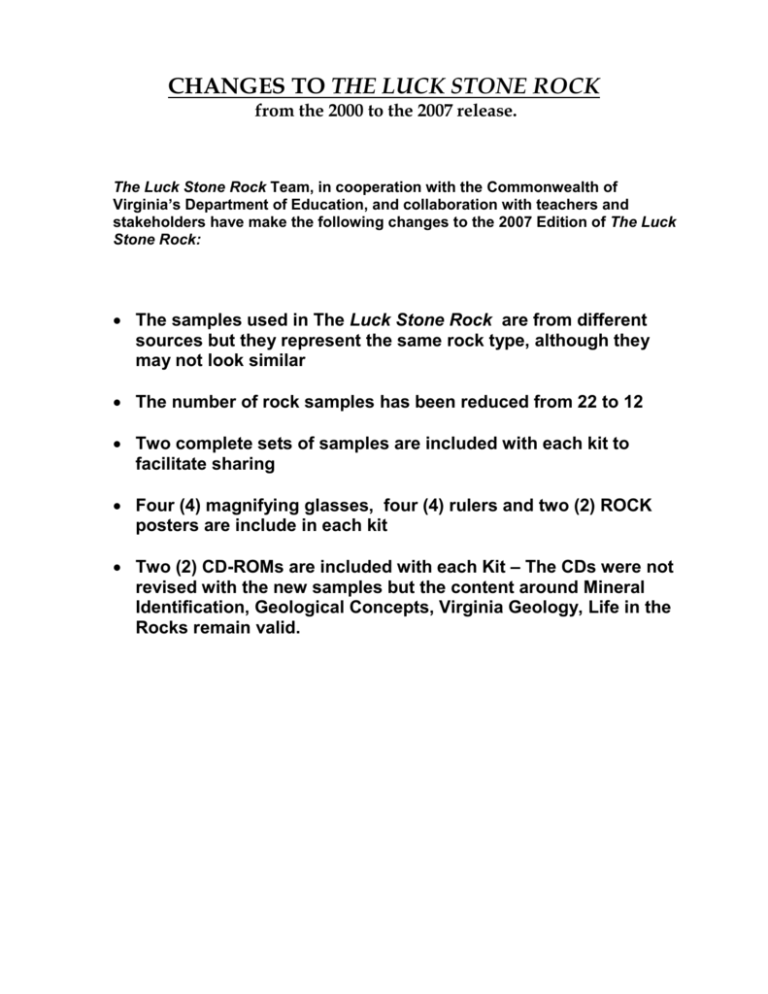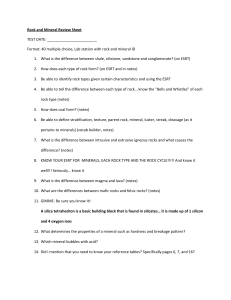CD R - Luck Stone
advertisement

CHANGES TO THE LUCK STONE ROCK from the 2000 to the 2007 release. The Luck Stone Rock Team, in cooperation with the Commonwealth of Virginia’s Department of Education, and collaboration with teachers and stakeholders have make the following changes to the 2007 Edition of The Luck Stone Rock: The samples used in The Luck Stone Rock are from different sources but they represent the same rock type, although they may not look similar The number of rock samples has been reduced from 22 to 12 Two complete sets of samples are included with each kit to facilitate sharing Four (4) magnifying glasses, four (4) rulers and two (2) ROCK posters are include in each kit Two (2) CD-ROMs are included with each Kit – The CDs were not revised with the new samples but the content around Mineral Identification, Geological Concepts, Virginia Geology, Life in the Rocks remain valid. MAXIMIZING THE BENEFIT from the RockVA CD-ROM: A Brief Overview Introduction – A group of students introduces the program in an engaging and dynamic method using video images to communicate in an interactive way to learn about rocks and minerals and how they are important for Virginia. Main Menu – A brief overview of the different components of the program that provides basic information about each part. A review of some CD screen prints can be found on following pages to help you navigate through specific sections noted below. Sections which are in larger print and underlined provide resources which have not been impacted by the new rock samples. Mineral Observation – Students are asked to answer multiple choice questions about several mineral samples provided in the Luck Stone Rock. The questions accompany a photograph of a mineral and are in the form “This Mineral Has…,” with 2-3 questions per mineral. The minerals used in this section are from the 2000 kit and will look different than the samples in the new 2007 kit. Mineral Identification – Students learn about the tests scientists perform to identify minerals. These include color, streak, hardness, luster, specific gravity, crystal form, and cleavage. This is a particularly good part to use with students to help prepare them to do Activity 1 (LP1) , Rock Observations. Rock Observation – Students are asked to answer multiple choice questions (similar to Mineral Observation) about the rocks provided in the 2000 release of the Luck Stone Kit. Once the set of questions for a rock is answered correctly, the rock is identified. It’s helpful to have the actual rock samples available during this part of the CD-ROM. The students can learn from this section although the samples in the kits have changed so the relationship between the photographs on the CD and the actual kit specimens are different. Rock Identification – Students learn the different ways rocks are formed and are asked to identify rocks as sedimentary, igneous, or metamorphic. The rock photos used in this section are from the 2000 kit and are different than those used for the new 2007 kit. Geological Concepts – Students learn how rocks are formed and changed over time. These concepts include the parts of the Earth, plate tectonics, weathering, and the different types of rocks. This is another particularly good part to use with students to help prepare them to do Activity 1, Rock Observations. Virginia Geology – Students learn about the five geological regions of Virginia, with a brief description and geological history of each. Life in the Rocks – Students learn about fossils, how they are formed, and the use of fossil fuels such as coal. It’s a Blast – A representative of the Luck Stone Corporation explains the many uses of rocks and how they are processed. Students also see a demonstration of an explosion in a rock quarry. Additional Icons – These icons can be accessed from the Main Menu and all subsequent Screens and provide additional help or information: Rock Talk – Provides students with a dictionary of terms related to the rocks and minerals that they will encounter in the program. Teachers themselves will find this an easy way to review or learn some basic ideas about the earth sciences. Rock Clock – Introduces students to the geologic time scale and provides a timeline, with interesting facts and pictures that list the different periods. Rock Solid (for teachers only) – Provides summaries and photographs of each of the original 22 rocks and minerals in the 2000 Luck Stone Rock Kit.






